After the impressive Ada Lovelace flagship GeForce RTX 4090, Nvidia is launching the GeForce RTX 4080, which is closer to the top model in terms of price than technology. ComputerBase clarifies what the RTX 4080 with AD103 is able to do using the Founders Edition as well as custom designs from Asus, MSI and Zotac in the test.
Table of contents
- 1 FE and custom designs from Asus, MSI & Zotac in comparison
- Four times Nvidia GeForce RTX 4080 in test
- GeForce RTX 4080: technology in detail
- Nvidia's GeForce RTX 4080 Founders Edition in detail
< li>Asus, MSI & Zotac: Custom designs in detail
- Test system and test methodology
- Clock rates under load
- Benchmarks with and without RT in 3,840 × 2,160
- Benchmarks with RT and FSR 2.x/DLSS 2.x in 3,840 × 2,160
- Benchmarks with and without RT in 2,560 × 1,440
- Benchmarks with and without RT in 5,120 × 2,880
- Benchmarks of Asus custom designs , MSI and Zotac
- Benchmarks in Applications
- Volume & Cooling
- Power consumption: games, YouTube, desktop
- Energy efficiency in FPS per watt
- RTX 4080 320 watts vs. RTX 4090 300/350 watts
- Clearly failed at the 3.0 GHz mark
- Price and availability
- Conclusion
Four times Nvidia GeForce RTX 4080 in the test
With the GeForce RTX 4090 (test), Nvidia presented the flagship of the Ada Lovelace generation at the beginning of October. The new top model with AD102 GPU and 24 GB memory convinces with brute performance even with a reduced TDP compared to the factory specification (450 watts). The price of at least 1,969 euros is record-breakingly high, but still fits in with the performance and competitive situation. But even among ComputerBase readers, the group of those who would pay that much money for a graphics card is small.
Ada Lovelace from 1,469 euros
With the GeForce RTX 4080 including AD103 GPU and 16 GB GDDR6X, Nvidia is launching the second-fastest model for the time being. Its RRP is 1,469 euros. From November 16, the version will be available in stores as a Founders Edition and in the form of custom designs. The RTX 4080 thus ranks 500 euros below the RTX 4090, but far above the level of its predecessor, the RTX 3080, whose RRP is currently 759 euros. The RTX 3080 Ti, RTX 3090 and RTX 3090 Ti are also currently trading at 1,089, 1,199 and 1,329 euros.
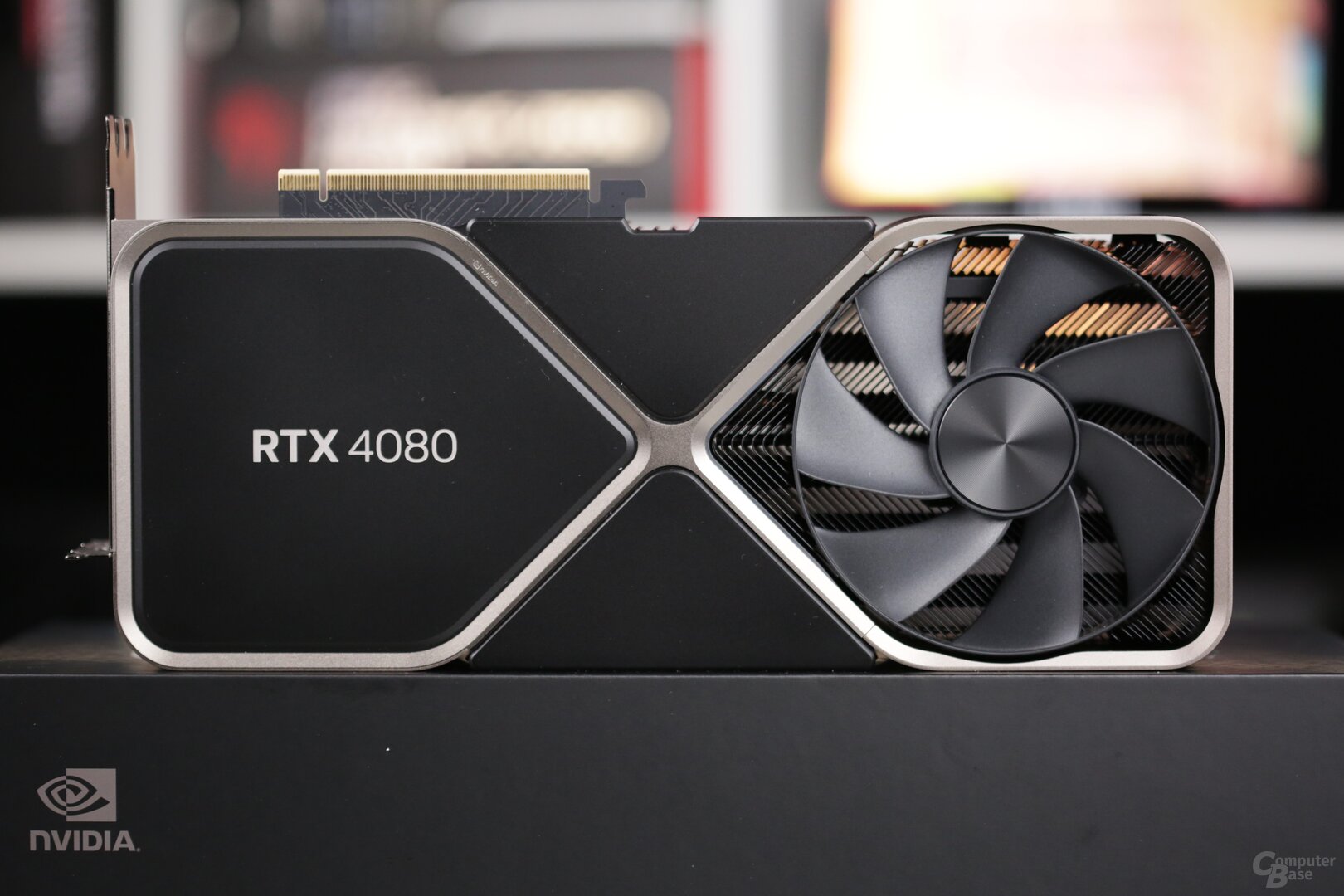 Review of the Nvidia GeForce RTX 4080 Founders Edition with AD103 GPU
Review of the Nvidia GeForce RTX 4080 Founders Edition with AD103 GPUIt won't be cheaper with Ada this year, because Nvidia canceled the second planned GeForce RTX 4080 with 12 GB (and smaller AD103 expansion) in response to heavy criticism before the start . According to rumors, the model will only see the light of day in early 2023 as the GeForce RTX 4070 Ti.
- GeForce RTX 4080: Custom themes at Alternate*
- GeForce RTX 4080: custom designs at Caseking*
- GeForce RTX 4080: custom designs at Mindfactory*
- GeForce RTX 4080: FE & Custom designs at NBB.de*
In today's test, the GeForce RTX 4080 has to assert itself against three competitors. Two come from Nvidia itself: Compared to the RTX 4090, the RTX 4080 has to prove that it cannot be completely outshone despite the massively fewer execution units. Compared to the fastest predecessor, the GeForce RTX 3090 Ti, it is important to achieve a relevant lead that justifies the surcharge.
However, it cannot yet be clarified how the duel GeForce RTX 4080 will fare will go up against AMD's new Radeon RX 7900 XTX, which is scheduled to be released on December 13 and will be able to compete with the RTX 4080 at a lower price.
FE and custom designs from Asus, MSI and Zotac in test
For this first test, ComputerBase uses a total of four different models:
- Nvidia GeForce RTX 4080 Founders Edition
- Asus GeForce RTX 4080 TUF Gaming OC
- MSI GeForce RTX 4080 Suprim X
- Zotac GeForce RTX 4080 AMP Extreme Airo
< p class="p text-width">All four graphics cards will be available in stores from November 16 at 3:00 p.m. German time. The Founders Edition will cost 1,469 euros, the custom designs will be a few hundred euros more expensive.
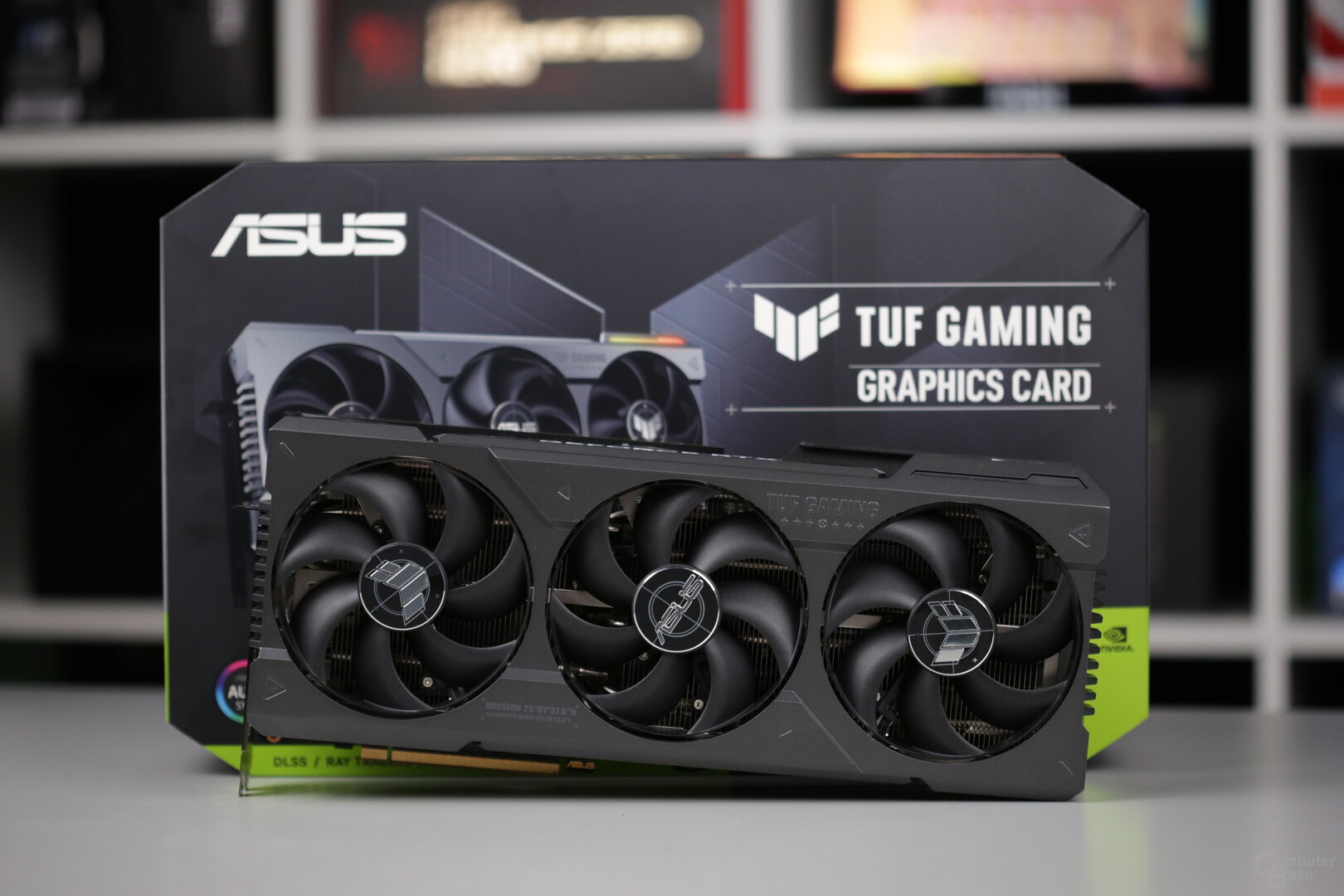 The Asus GeForce RTX 4080 TUF Gaming OC
The Asus GeForce RTX 4080 TUF Gaming OC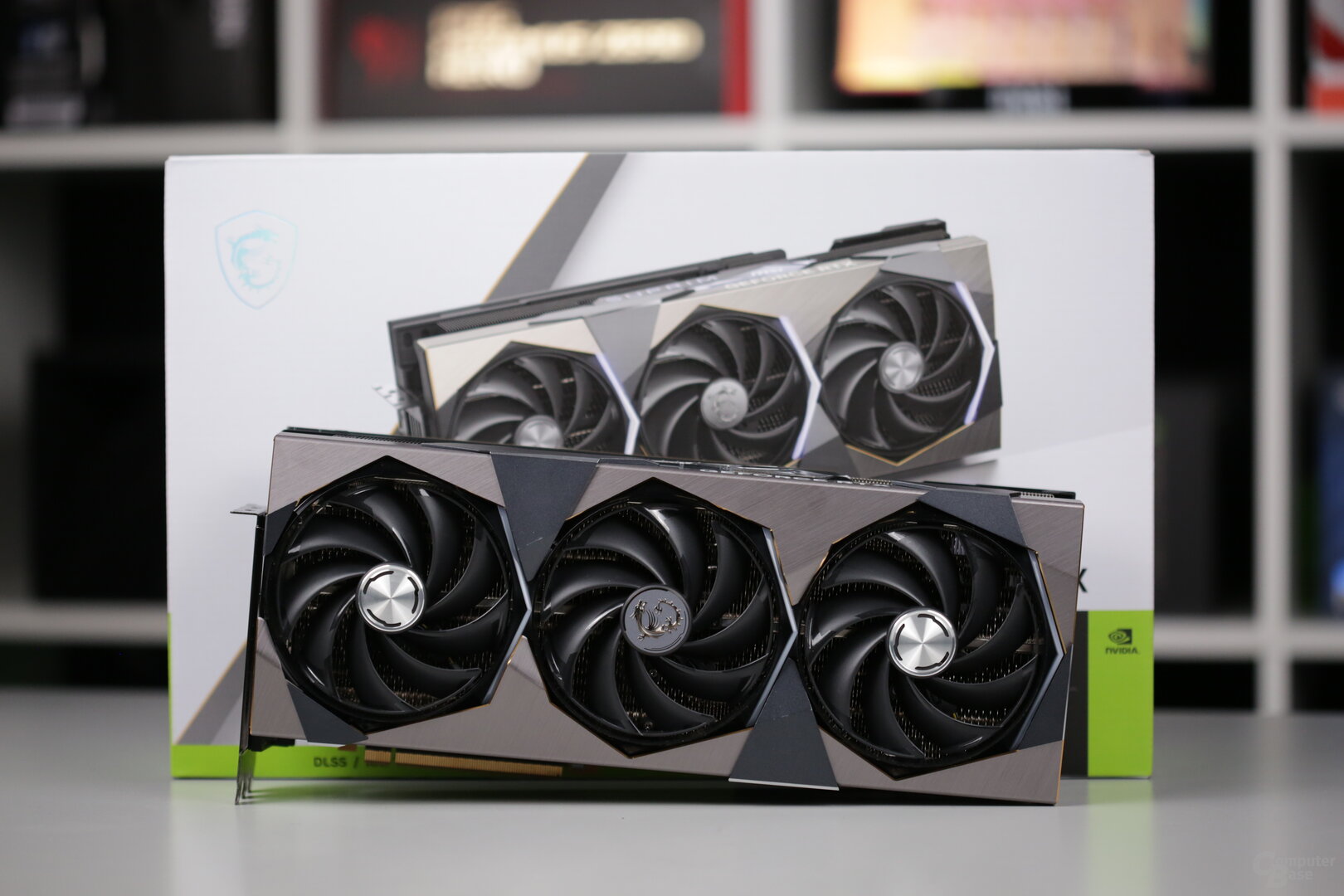 The MSI GeForce RTX 4080 Suprim X
The MSI GeForce RTX 4080 Suprim X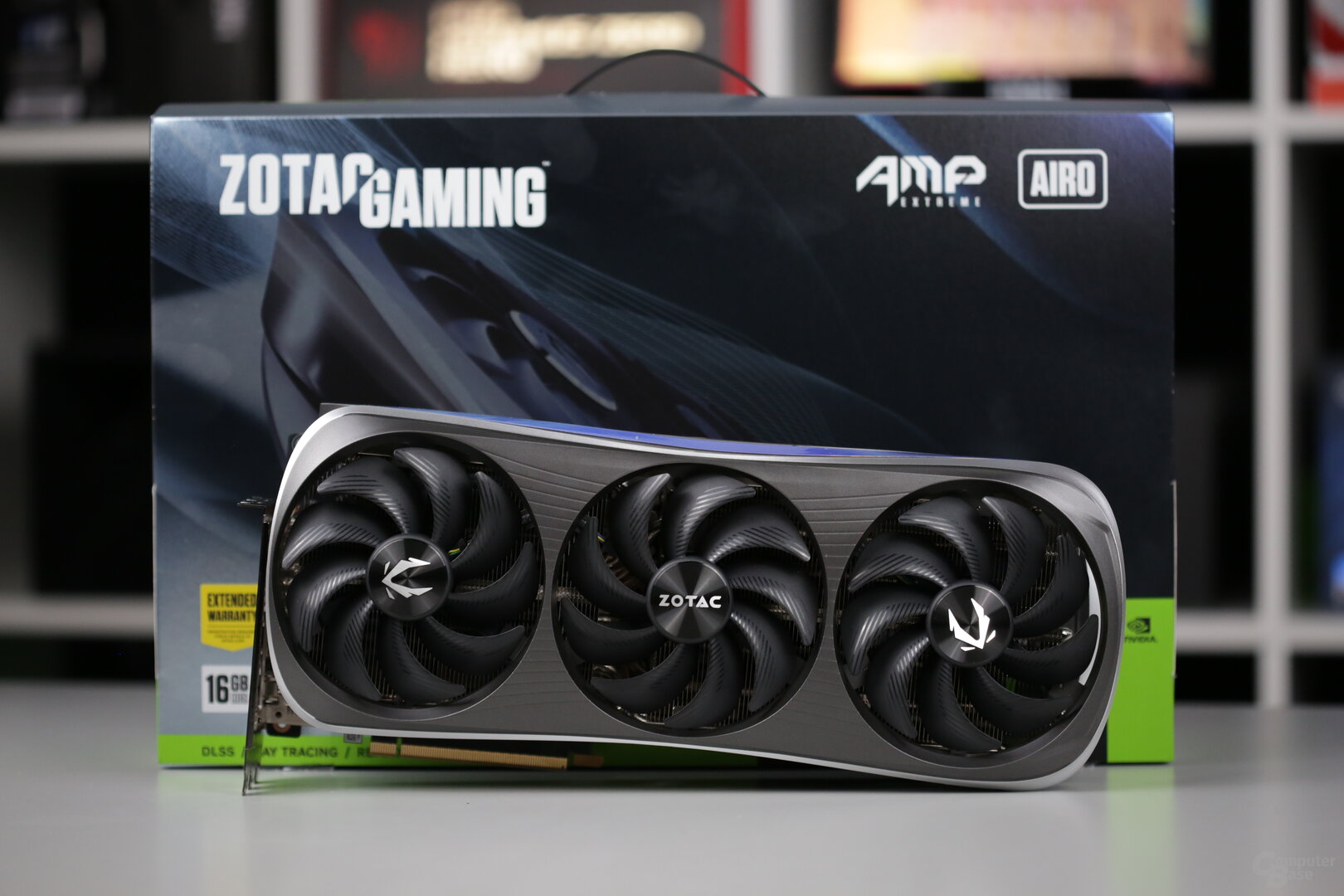 The Zotac GeForce RTX 4080 AMP! Airo
The Zotac GeForce RTX 4080 AMP! AiroA small teaser right at the start
Detailed benchmarks can be found on page 2 of this article. However, the following teaser gives an impression of what Nvidia Ada Lovelace is capable of doing in the form of the AD103 on the GeForce RTX 4080.
It's that fast RTX 4080
- Rasterizer, UHD, AVG-FPS
- Raytracing, UHD, AVG-FPS
Edit 5 entries That's how fast the RTX 4080 is – Rasterizer, UHD, AVG-FPS Inflow charts All None
- Call of Duty: Vanguard – 3840×2160: FPS, Average
- Cyberpunk 2077 – 3840×2160: FPS, Average
- Deathloop – 3840×2160: FPS, Average
- Doom Eternal – 3840×2160: FPS, Average
- Dying Light 2 – 3840×2160: FPS, Average
- F1 22 – 3840×2160: FPS, Average
- Far Cry 6 – 3840×2160: FPS, Average
- Forza Horizon 5 – 3840×2160: FPS, Average
- Ghostwire Tokyo – 3840×2160: FPS, Average
- God of War – 3840×2160: FPS, Average
- Guardians of the Galaxy – 3840×2160: FPS, Average
- Halo Infinite – 3840×2160: FPS, Average Saints Row – 3840×2160: FPS, Average
- Shadow Warrior 3 – 3840×2160: FPS, Average
- Sniper Elite 5 – 3840×2160: FPS, Average
- Spider-Man Remastered – 3840×2160: FPS, Average
- Tiny Tina's Wonderlands – 3840×2160: FPS, Average
li>
-
- Nvidia GeForce RTX 4090 FE100.0
- Nvidia GeForce RTX 4080 FE74.5
- Nvidia GeForce RTX 3090 Ti62, 9
- Nvidia GeForce RTX 3080 Ti FE55,7
- AMD Radeon RX 6900 XT52,3
- Nvidia GeForce RTX 3080 FE50.0
- AMD Radeon RX 6800 XT47,4
- AMD Radeon RX 680040,2
- Nvidia GeForce RTX 3070 FE34,5
- AMD Radeon RX 6700 XT31,8
- Nvidia GeForce RTX 3060 Ti FE30, 2
Unit: percent 5 entries Edit This is how fast the RTX 4080 is – Raytracing, UHD, AVG FPS Inflow charts All None
- Cyberpunk 2077 (RT) – 3840 × 2160: FPS, average
- Deathloop (RT) – 3840×2160: FPS, Average
- Doom Eternal (RT) – 3840×2160: FPS, Average
- Dying Light 2 ( RT) – 3840 × 2160: FPS, Average
- F1 22 (RT) – 3840 × 2160: FPS, Average
- Far Cry 6 (RT) – 3840 × 2160: FPS, Average
- Ghostwire Tokyo (RT) – 3840×2160: FPS, Average
- Guardians of the Galaxy (RT) – 3840×2160: FPS, Average
- Metro Exodus Enhanced (RT) – 3840 × 2160: FPS, Average
- Saints Row (RT) – 3840 × 2160: FPS, Average
- Spider-Man Remastered (RT) – 3840 × 2160: FPS, Average
li>
-
- Nvidia GeForce RTX 4090 FE100.0
- Nvidia GeForce RTX 4080 FE72.6
- Nvidia GeForce RTX 3090 Ti60,6
- Nvidia GeForce RTX 3080 Ti FE53,0
- Nvidia GeForce RTX 3080 FE43,6
- AMD Radeon RX 6900 XT36,7
- AMD Radeon RX 6800 XT33,3
- AMD Radeon RX 680028,2
- Nvidia GeForce RTX 3070 FE22,5
- Nvidia GeForce RTX 3060 Ti FE20,4
Unit: percent
GeForce RTX 4080: technology in detail
Nvidia's GeForce RTX 4090 relies on the large AD102 GPU, while the RTX 4080 does not. Because unlike Ampere, where the RTX 3080 and RTX 3080 Ti are also based on the GA102 chip of the RTX 3090 (later 3090 Ti) and do not differ by 15 percent in raw performance, the GeForce RTX 4080 already comes with the much smaller AD103 Chip therefore.
AD103 instead of AD102 with 256-bit interface
A chip size of 379 to 609 mm² and a number of transistors from 45.9 billion to 76.3 billion (AD103 to AD102 respectively) speak a clear language: Both GPUs are very different.
The GeForce RTX 4080 can “only” access 76 streaming multiprocessors, which results in 9,728 shader units, 76 ray tracing and 304 tensor cores (full configuration: 80 SMs and thus 10,240 ALUs). The GeForce RTX 4090, on the other hand, can fall back on 16,384 shader units, 128 ray tracing or 512 tensor cores (full configuration: 144 SMs and thus 18,432 ALUs).
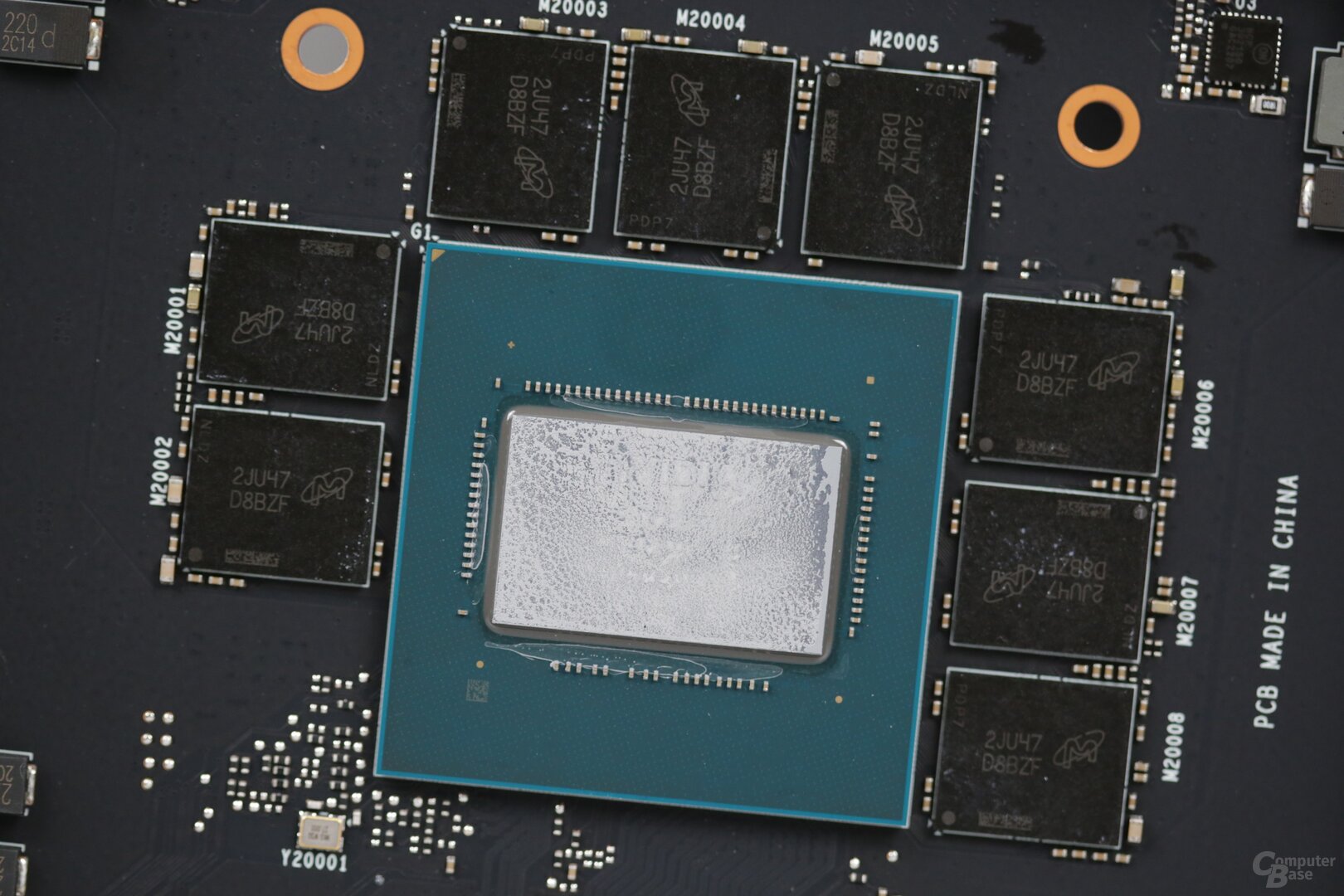 The GeForce RTX 4080 relies on Nvidia's AD103- GPU
The GeForce RTX 4080 relies on Nvidia's AD103- GPU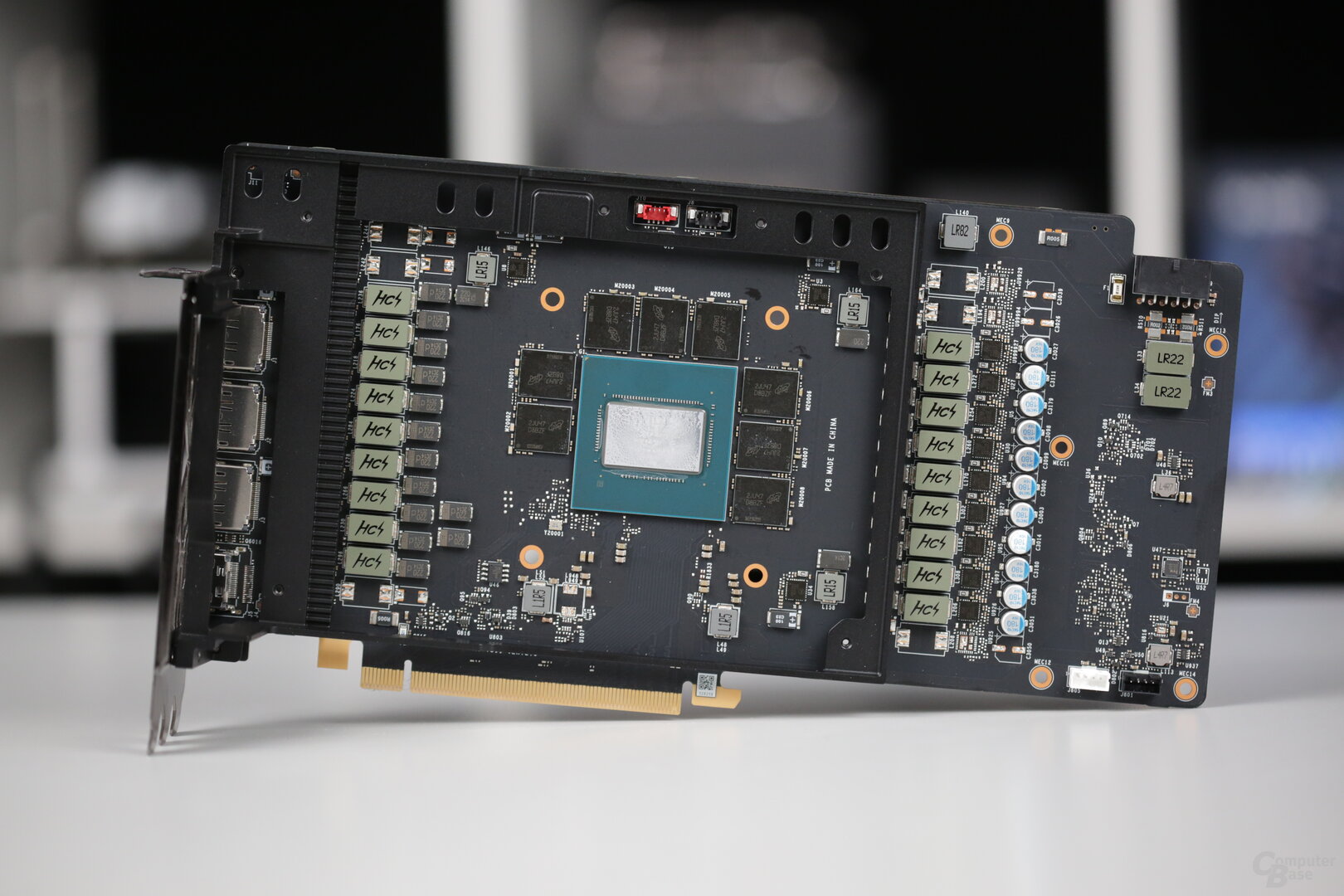 The PCB of the MSI GeForce RTX 4080 Suprim X with AD103 GPU
The PCB of the MSI GeForce RTX 4080 Suprim X with AD103 GPU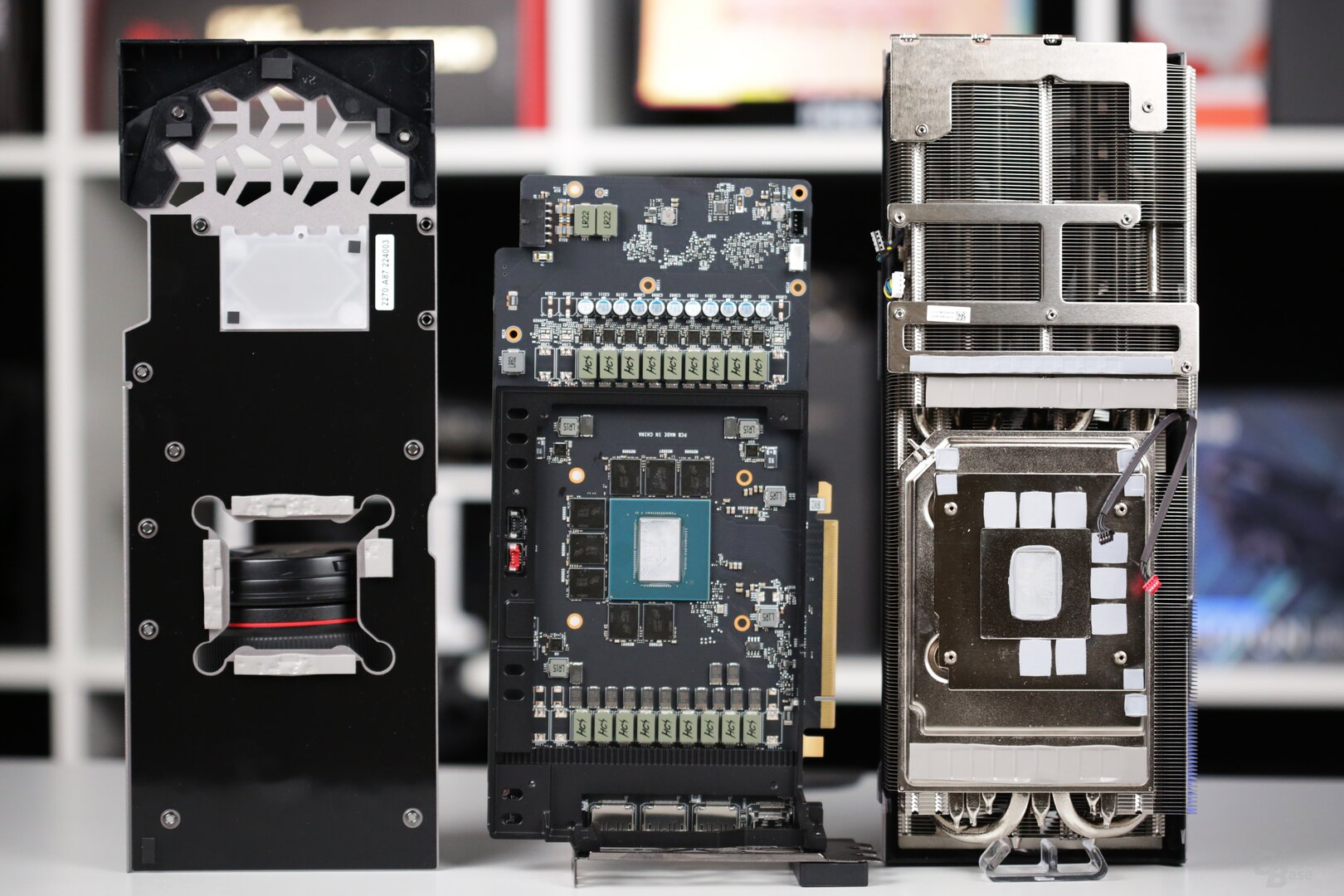 PCB and cooling system of the MSI GeForce RTX 4080 Suprim X
PCB and cooling system of the MSI GeForce RTX 4080 Suprim XWhile the L1 cache on the GeForce RTX 4080 scales with the streaming multiprocessors and, at 9,728 KB, is also significantly smaller than on the GeForce RTX 4090, the L2 cache is interestingly only slightly reduced at 65,536 KB compared to 73,728 KB. But that's also because the AD102 actually has 96 MB and only runs on the RTX 4090 with the handbrake on.
-
Nvidia AD103 GPU block diagram (Image: Nvidia)
Image 1 of 2
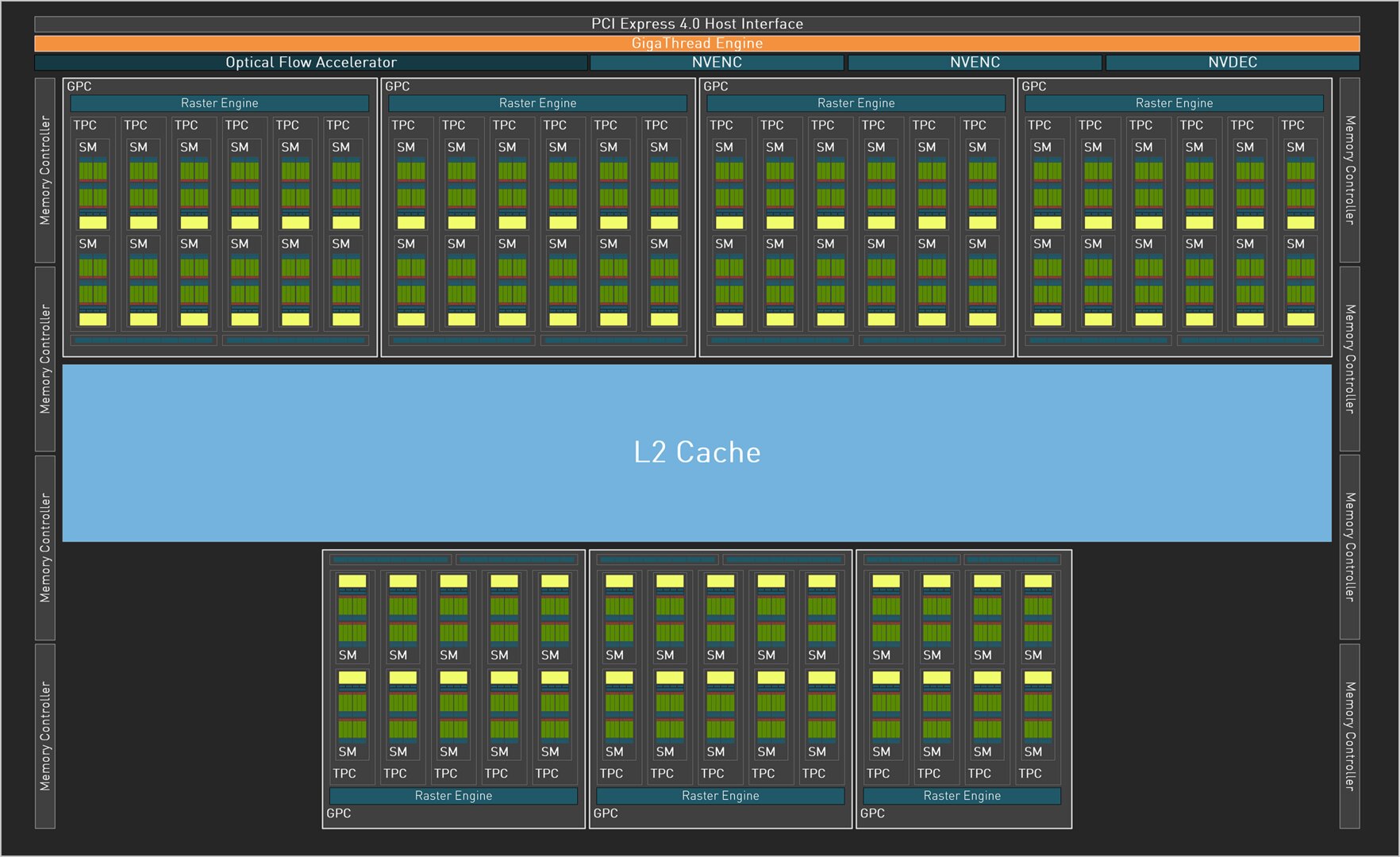 Nvidia RTX 4080 block diagram (Image: Nvidia)
Nvidia RTX 4080 block diagram (Image: Nvidia)The memory interface of the GeForce RTX 4080 has also been reduced to 256 bits compared to the 384 bits of the larger card, the memory expansion is 16 GB of the GDDR6X type. At 22.4 Gbps, the data throughput of the memory is slightly higher (21 Gbps with the RTX 4090), the combined memory bandwidth results in 717 GB/s.
Nvidia names for the GeForce RTX 4080 has a base clock of 2,210 MHz, while the average turbo is given as 2,510 MHz. The clock is therefore only slightly below that of the RTX 4090. In this case, too, it can be assumed that the graphics card clocks higher in gaming practice.
320 watts TDP is the reference
As with the RTX 3090, 320 watts TDP are set ( RTX 4090: 450 watts), with Nvidia already pointing out that the power consumption can also be lower depending on the game and graphics details – depending on the load, as the RTX 4090 has already shown.
The underlying technology in the form of the Ada Lovelace architecture, together with the modern N4 production at TSMC and the complete feature set including DLSS 3, has remained absolutely identical. However, the editors will not go into detail again at this point, because there was a detailed article on this back in September:
- Nvidia GeForce RTX 4000 : More details on architecture, DLSS 3 and Founders Editions
1 × NVDEC (5th Gen) 1 × NVENC (7th Gen)
1 × NVDEC (5th Gen) TDP 450W 320W 450W 320W
Nvidia's GeForce RTX 4080 Founders Edition in detail
The Nvidia GeForce RTX 4080 Founders Edition will be available from November 16 at 3:00 p.m. (possibly a few minutes earlier) via notebooksbilliger.de* for a price of 1,469 euros. Other retailers will not offer the model, but will only focus on the custom designs.
- GeForce RTX 4080: FE & Custom designs at NBB.de*
The 80s uses the cooler of the 90s as FE
Unlike the last generation, the 80s based on Ada Lovelace uses the same cooler as the RTX 4090 FE, which results in the same dimensions (3.0 slots, 30.5 cm length) and an almost identical weight of 2,128 g . The latter shows that Nvidia has also left the cooler structure itself unchanged, so that there is again a vapor chamber, heat pipes and a very large heat sink. The two axial fans, which stand still at low temperatures, come back to a diameter of 115 mm. The starting speed is pleasantly low at 500 rpm.
-
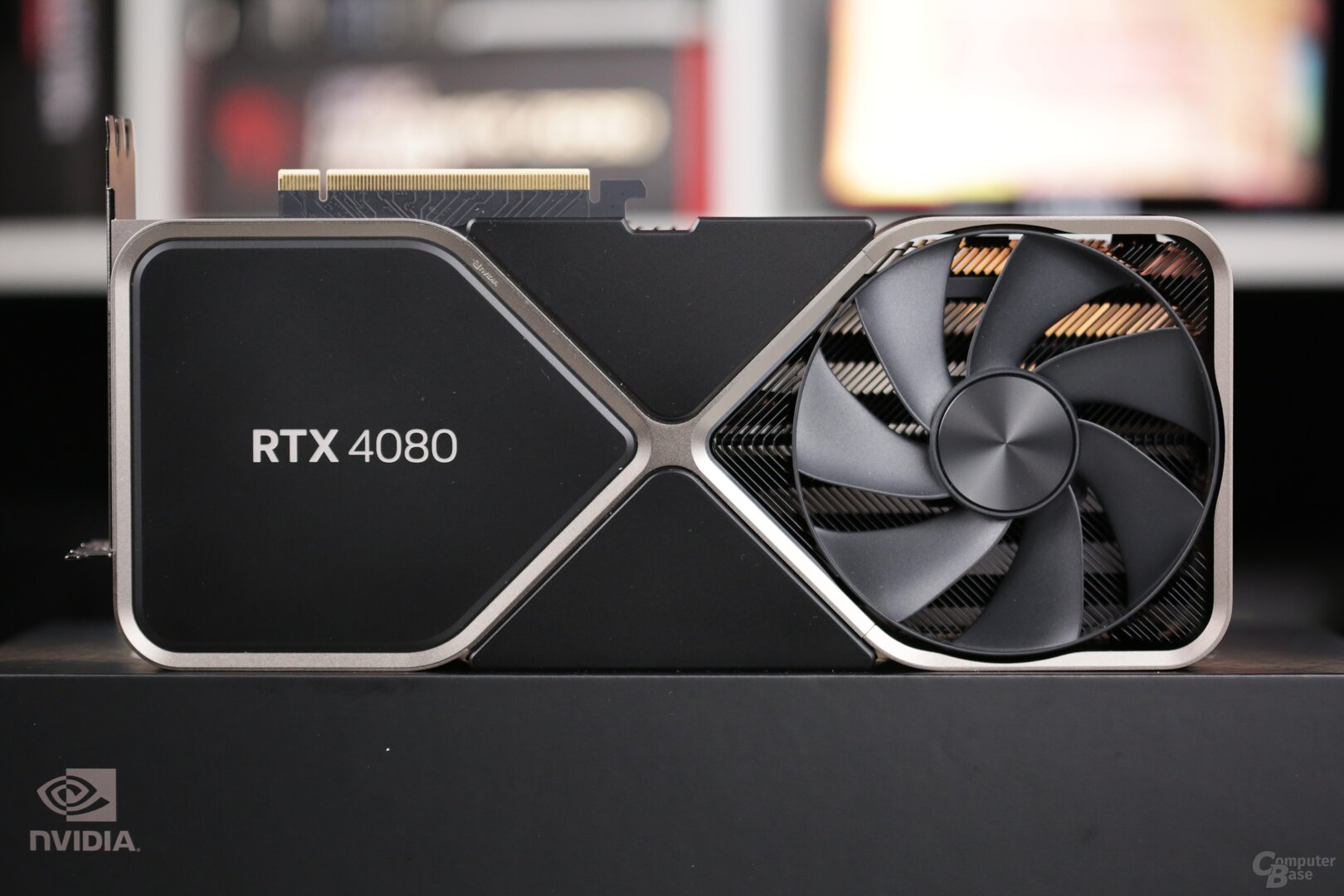 The Nvidia GeForce RTX 4080 Founders Edition with AD103 GPU im Test
The Nvidia GeForce RTX 4080 Founders Edition with AD103 GPU im Test
Image 1 of 2
With the structure, the excellent look and feel of the GeForce RTX 4080 FE have remained the same. Since the Ampere generation, Nvidia hasn't fooled anyone in this regard, and the new custom cards haven't changed that either.
And it was RGB! ?
The reserved but really chic RGB lighting also fits into the elegant look. Yes, RGB is not a typo, because the Founders Edition of the RTX 4000 generation can not only shine white on the back as before, but also in other colors. What the editors of the RTX 4090 still considered a result of the high workload because it could not be reproduced has now been proven to be possible with the RTX 3080. What specifically causes the Founders Edition to sporadically not only light up white is just as unknown as a way to control the effect. Nvidia left questions about the topic unanswered.
Nvidia is not surprisingly sticking to the reference clock rates for the model. The average turbo is specified as 2,505 MHz, the factory TDP is 320 watts. If you want, you can increase the power limit to 355 watts. That's a much smaller premium compared to the RTX 4090, which can be driven from 450 to 600 watts even as an FE.
The new 12VHPWR according to the PCIe 5.0 standard is used as the power connector. If your power supply does not have such a connector, you can operate the graphics card using the supplied adapter (16-pin to 3×8-pin, maximum 450 watts possible).
 All RTX 4080 come in test with an adapter to 3×8 pin for up to 450 watts TDP
All RTX 4080 come in test with an adapter to 3×8 pin for up to 450 watts TDP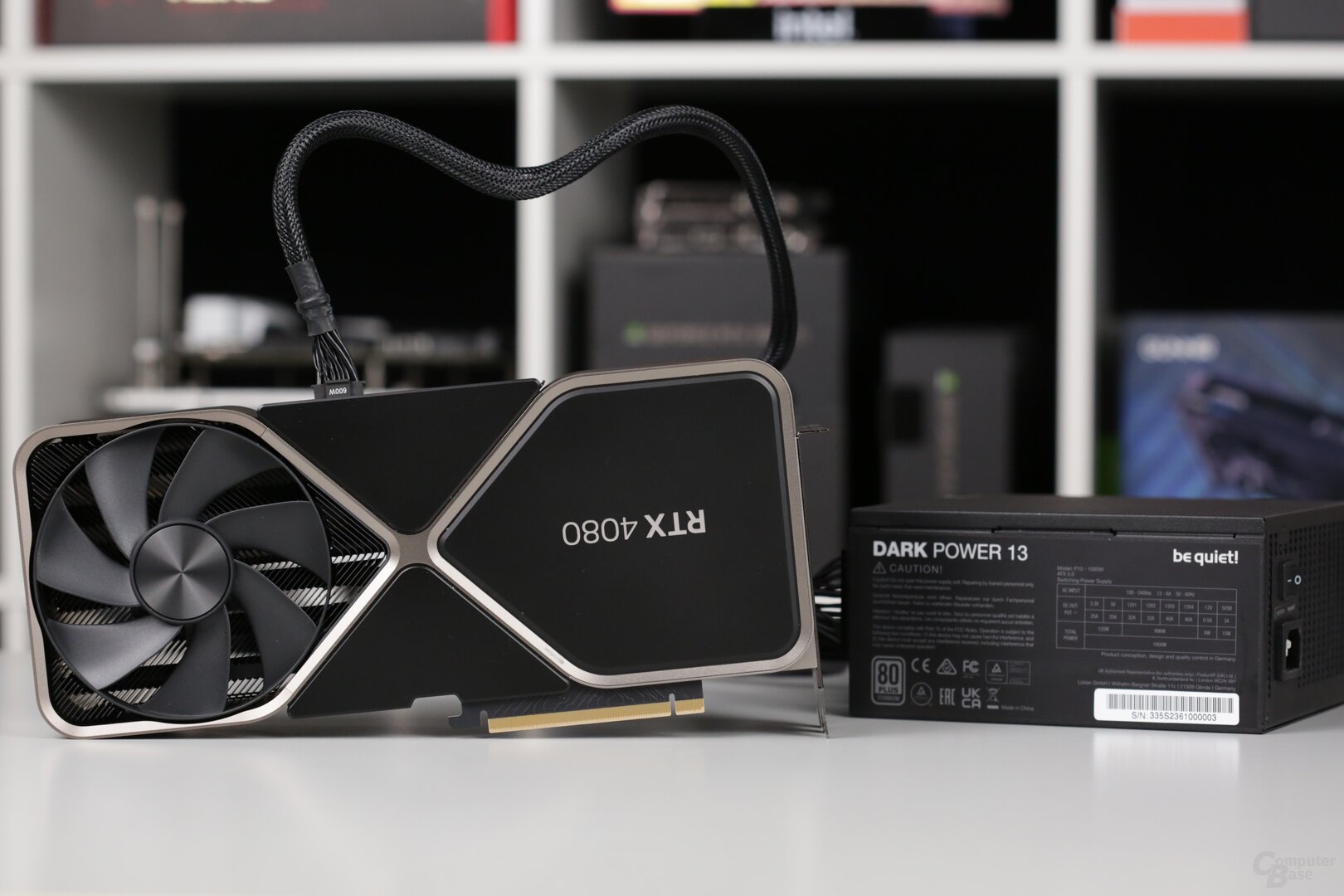 Alternatively, the graphics card can be operated directly with a 12VHPWR connection from the power supply
Alternatively, the graphics card can be operated directly with a 12VHPWR connection from the power supplyWith the Nvidia GeForce RTX 4080 FE, monitors can be controlled via three DisplayPort 1.4a DSC interfaces or via an HDMI 2.1 connector.
Asus, MSI & Zotac: Custom designs in detail
In addition to Nvidia's Founders Edition, custom designs from Asus, MSI and Zotac are also included in the test. Specifically, the models Asus GeForce RTX 4080 TUF OC, MSI GeForce RTX 4080 Suprim X and Zotac GeForce RTX 4080 AMP Extreme Airo were measured below.
While the last two are the respective flagship models of the manufacturers, the TUF is “only” the second largest example. But since Ampere, TUF no longer has to hide behind Strix at Asus. The custom maps will go on sale to coincide with the Founders Edition on November 16 at 3:00 p.m.
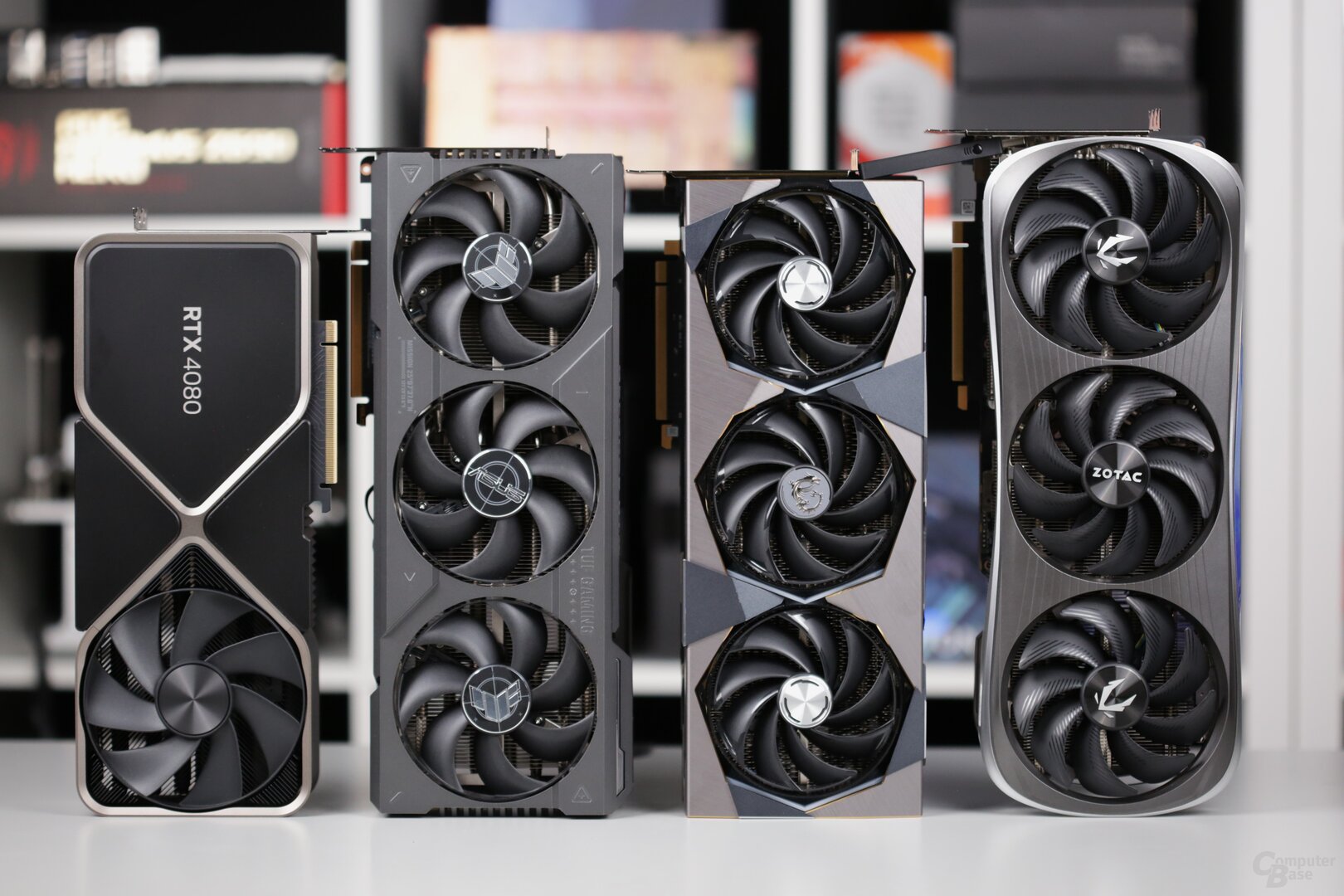 RTX 4080: FE, Asus TUF Gaming OC, MSI Suprim X and Zotac AMP! Airo in comparison (left to right)
RTX 4080: FE, Asus TUF Gaming OC, MSI Suprim X and Zotac AMP! Airo in comparison (left to right)Like the FE, the three partner cards also rely on the cooler design of the larger GeForce RTX 4090, although there are some slight adjustments under the hood (heat pipes, radiator). This does not affect the dimensions of the graphics cards. Accordingly, the custom cards from Asus, MSI and Zotac are very large and before buying you should check whether the hardware fits into your own case without any problems.
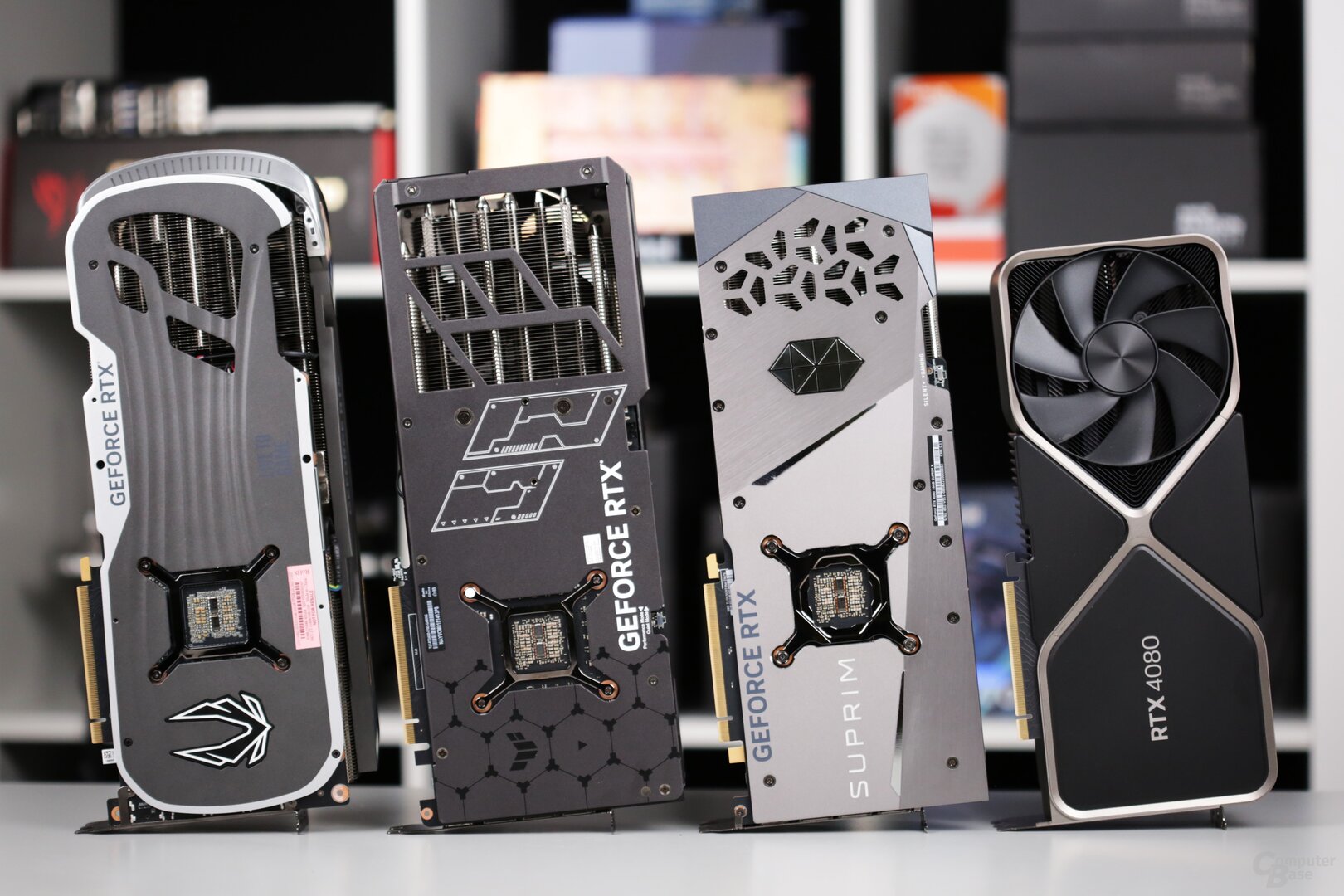 RTX 4080: FE, Asus TUF Gaming OC, MSI Suprim X and Zotac AMP! Airo in comparison (from right to left)
RTX 4080: FE, Asus TUF Gaming OC, MSI Suprim X and Zotac AMP! Airo in comparison (from right to left)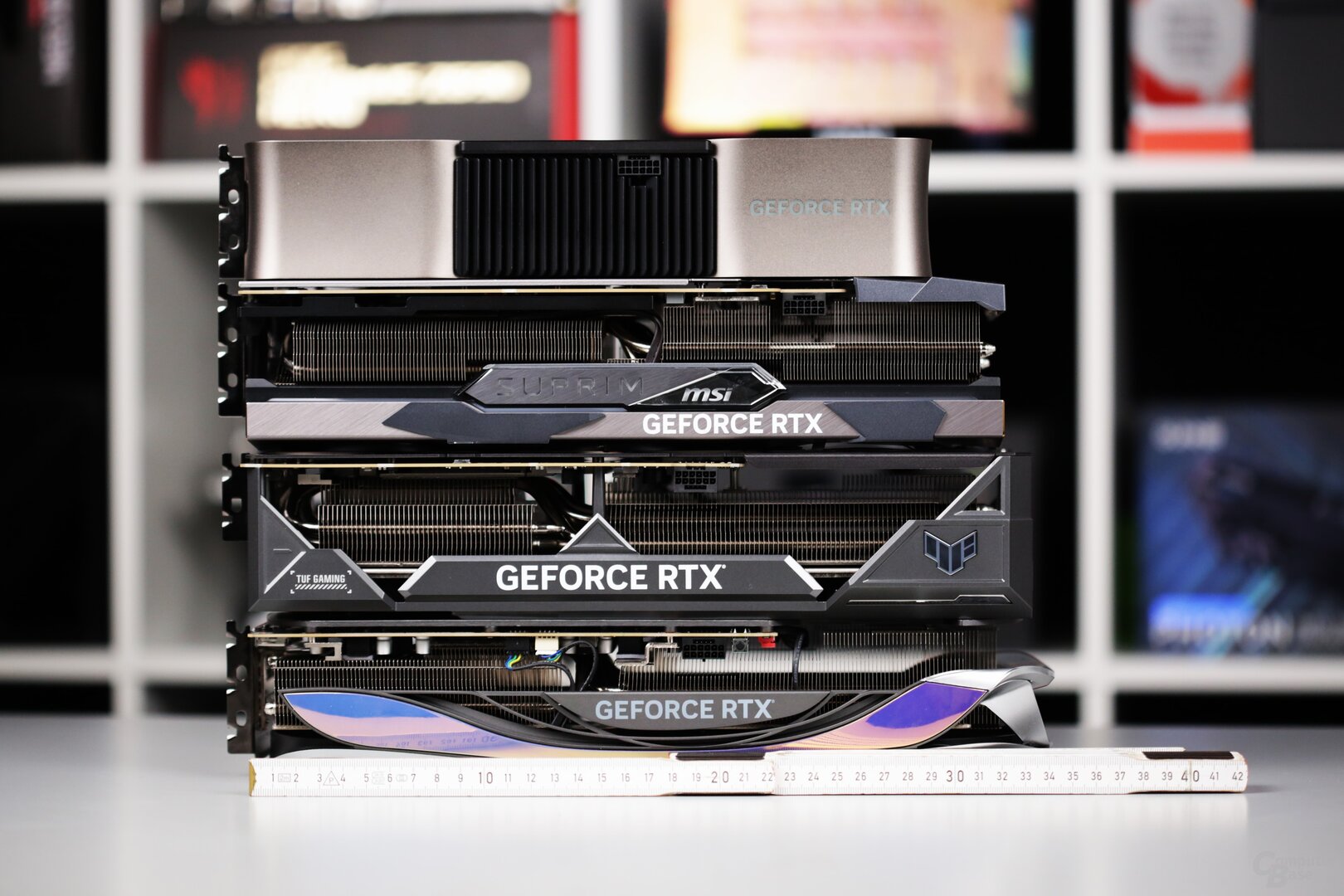 The longest RTX 4080 custom Design in test comes from Zotac
The longest RTX 4080 custom Design in test comes from Zotac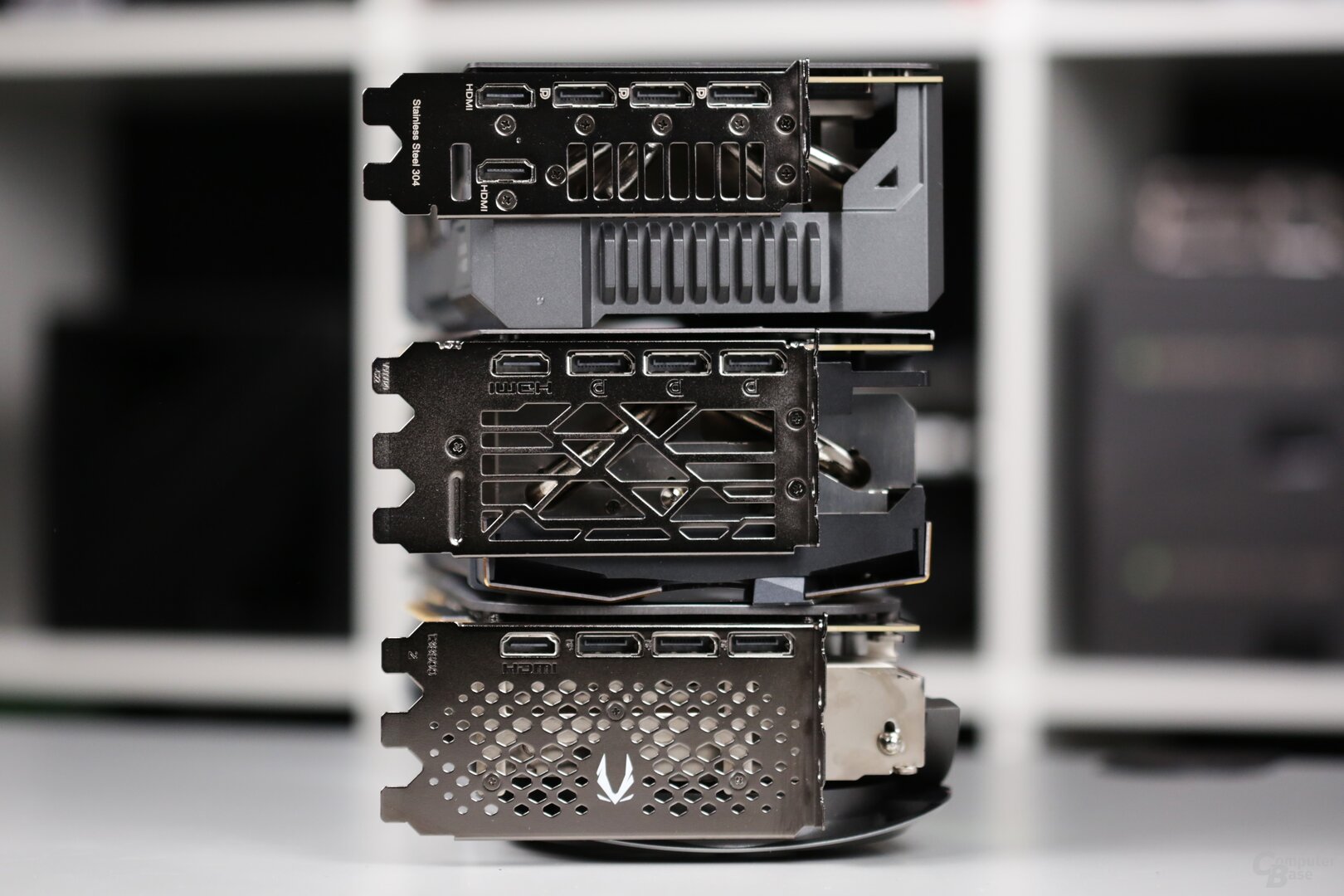 Asus offers a second HDMI port on the I/O panel
Asus offers a second HDMI port on the I/O panelAsus GeForce RTX 4080 TUF Gaming OC overview
The Asus GeForce RTX 4080 TUF Gaming OC relies on proven quality without getting bogged down in the little things. There is still a small RGB lighting, it looks out of place as usual. Apart from that, the feel and look of the graphics card can be described as absolutely high quality. Like the Founders Edition, the overall structure falls into the “noble and reserved” category.
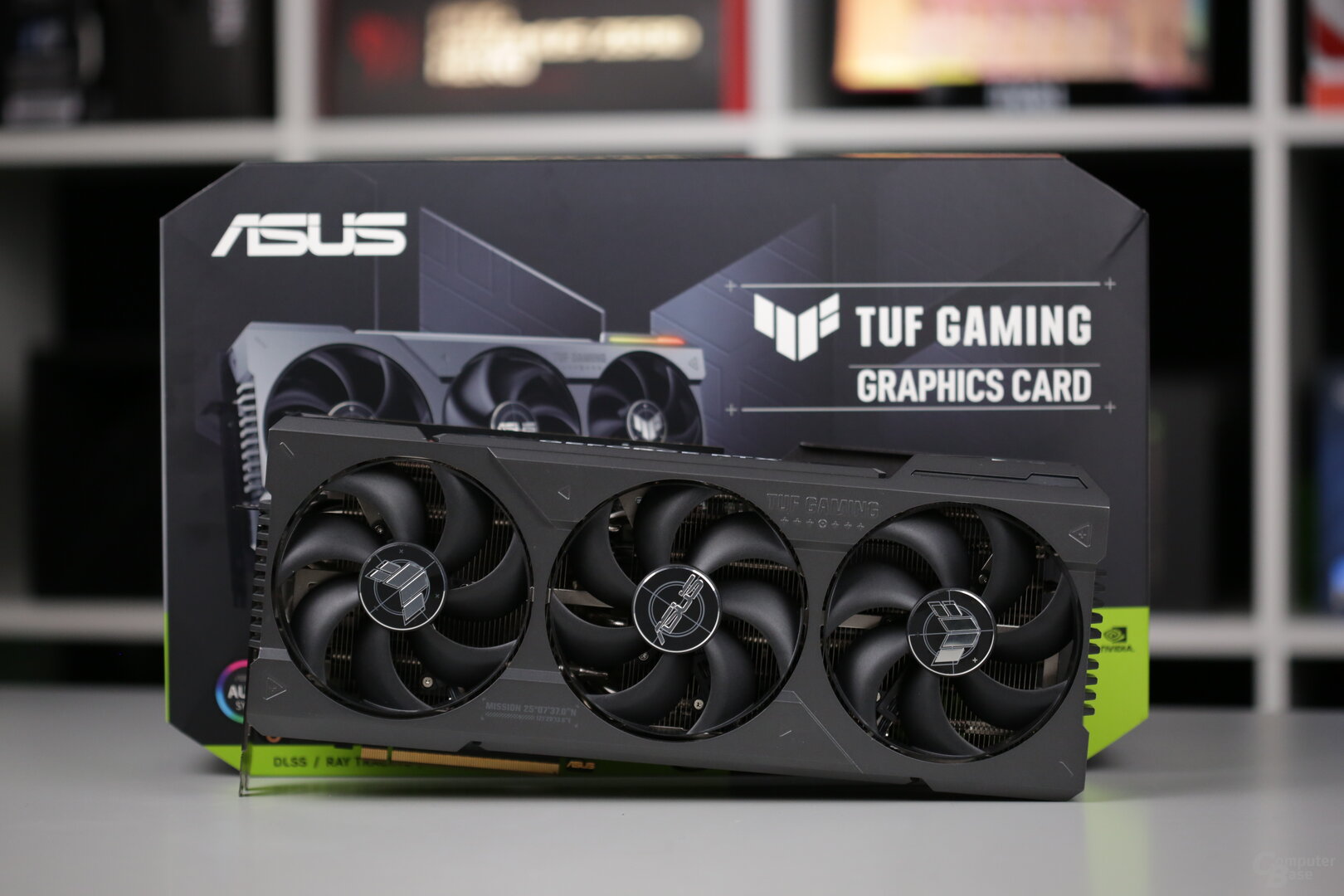 The Asus GeForce RTX 4080 TUF Gaming OC
The Asus GeForce RTX 4080 TUF Gaming OCMSI GeForce RTX 4080 Suprim X at a glance
The MSI GeForce RTX 4080 Suprim X is also a graphics card that looks absolutely chic and looks a bit more playful. The RGB lighting is significantly larger, but also significantly fancier without being over the top or appearing like a fairground.
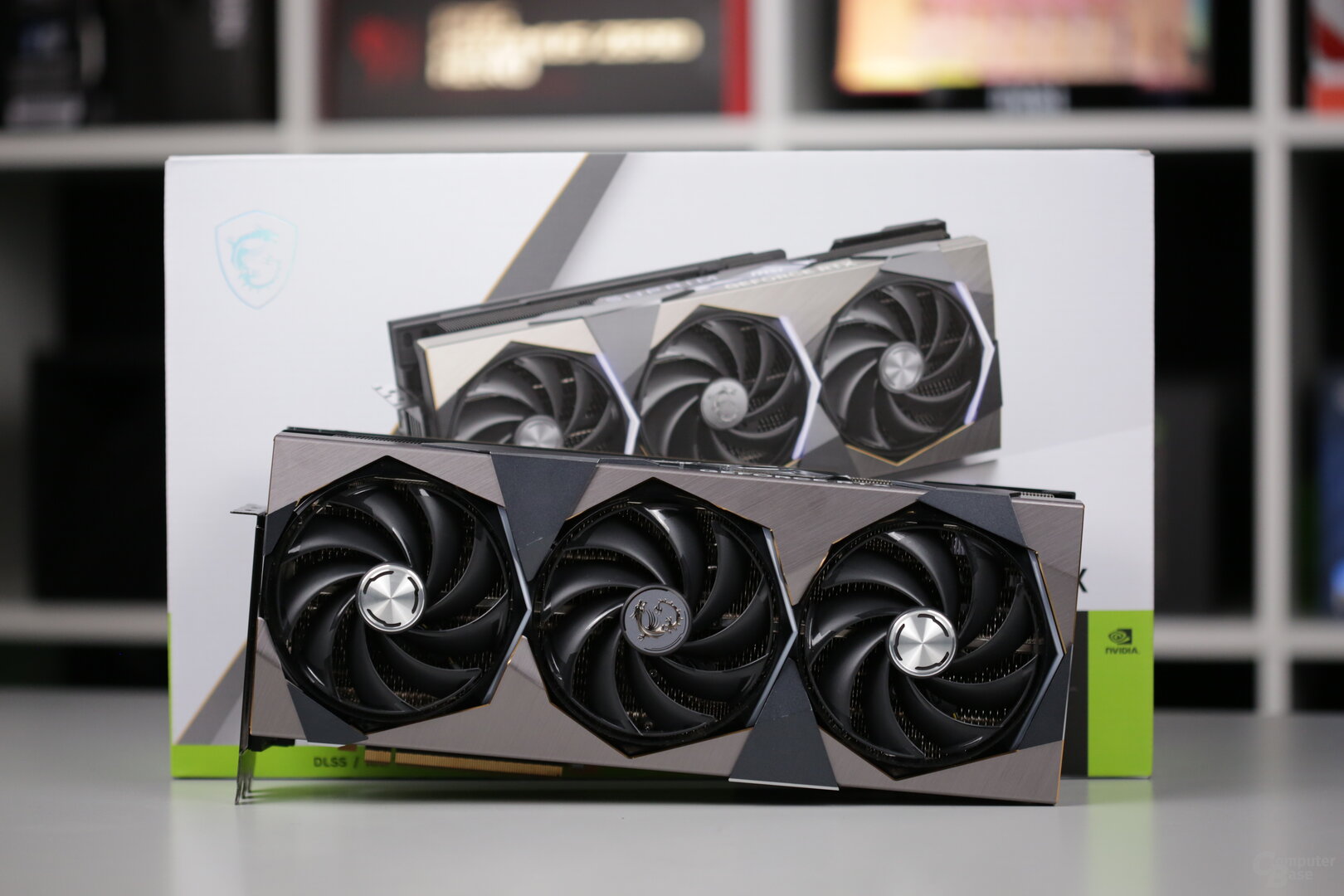 The MSI GeForce RTX 4080 Suprim X
The MSI GeForce RTX 4080 Suprim XOverview of Zotac GeForce RTX 4080 AMP Extreme Airo
The Zotac GeForce RTX 4080 AMP Extreme Airo goes one step further. Anyone who likes striking RGB lighting will be happy with the model, because RGB is definitely the focus there with a lot of space and color. The 3D accelerator no longer appears reserved or classy, and the feel cannot keep up with the two competing models. The many radii on the cooler clearly differentiate the graphics card from other models on the market.
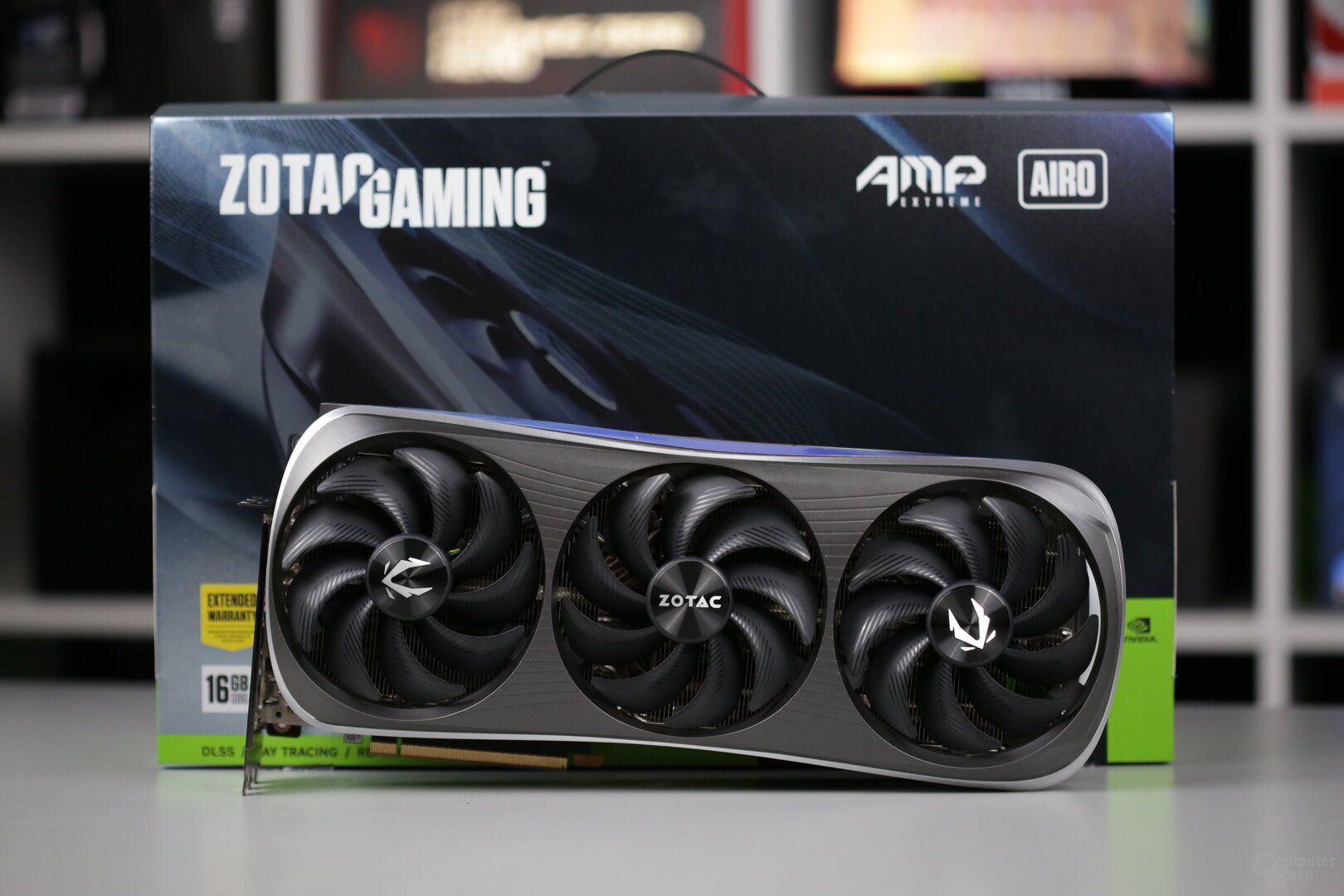 The Zotac GeForce RTX 4080 AMP! Airo
The Zotac GeForce RTX 4080 AMP! AiroAll three cooling systems are very large
There is little to report about the cooler, because the actual structure is the same for all manufacturers: There is a very large heat sink, a lot of heat pipes and three large axial fans. The Zotac GeForce RTX 4080 AMP Extreme Airo has the smallest cooler, but it is still very large. The Asus and MSI cards don't sacrifice much in terms of size. All three graphics cards come with a bracket so that the board does not bend when installed.
Custom designs with 320 watt TDP ex works
It's not surprising that all three manufacturers have the Clock screw turned. Asus specifies an average turbo of 2,595 MHz for the GeForce RTX 4080 TUF OC, which is 90 MHz more than the Founders Edition. The TDP, on the other hand, has remained the same at 320 watts, but can be increased to 352 watts.
MSI calls a clock of 2,625 MHz for the GeForce RTX 4080 Suprim X, which means a plus of 120 MHz and at the same time the highest clock in the test field. The standard TDP is retained at 320 watts, but the scope has been significantly increased with 400 watts.
The Zotac GeForce RTX 4080 AMP Extreme Airo comes with a turbo clock of 2,565 MHz (+60 MHz), while the TDP is 320 watts. Here the maximum is 368 watts. A 12VHPWR connector is required for all three graphics cards, alternatively a 3×8-pin adapter is included.
There are two BIOS versions Standard
It doesn't matter whether it's the TUF, Suprim X or AMP Extreme Airo: all three test subjects offer two different BIOS versions that only have an impact on the fan control. Asus has Quiet and Performance BIOS (Default: Performance), MSI Silent and Gaming (Default: Silent) and Zotac Quiet and Performance (Default: Performance). The latter does not have the usual BIOS switch, but a button that has to be pressed during operation. Then the RGBs briefly light up blue for silent or red for performance.
TUF OC MSI RTX 4080
Suprim X Zotac RTX 4080
AMP Extreme Airo Nvidia RTX 4080
Founders Edition CardPCB Design Asus MSI Zotac Nvidia Length Width 35.0 14.5cm 33.5cm 14.0cm 36.0cm 15.0cm 30.5cm 13.5cm Weight 1926g 2359g 1,949 g 2,128 g Power supply 1 × 16-pin (12VHPWR, PCIe 5.0)
3 × 8-pin per adapter Cooler Design TUF, 3.65 slots Suprim X, 3.8 slots AMP, 3.6 slots Founders Edition, 3.0 slots heat sink vapor chamber, heat pipes
Aluminium core/radiator heat pipes
Aluminium core/radiator vapor chamber, heat pipes
Aluminum core/radiator Fan 3 × 104 mm (axial) 3 × 100 mm (axial) 3 × 105 mm (axial) 2 × 115 mm (axial) Fan switched off (2D) Yes Starting speed 500 revolutions 1,000 revolutions 500 revolutions Clock
GPU Base 2205MHz GPU Average 2595 2625MHz 2565MHz 2505MHz GPU Max 2880MHz 2880MHz 2835MHz 2790MHz Memory 11200MHz Memory Size 16GB GDDR6X Power consumption Standard TGP 320 watts Max TDP 352 watts 400 watts 368 watts 355 watts Connections 3 x DisplayPort 1.4 DSC
2 x HDMI 2.1 3 x DisplayPort 1.4 DSC
1 x HDMI 2.1
Test system and test methodology
ComputerBase has extensively tested the GeForce RTX 4080 over the past seven days. The following test system and a methodology adapted to older articles were used in a new test course that was explicitly geared towards the next-gen graphics card.
The processor in the test system is still the Intel Core i9-12900K (factory setting), which does its job on an Asus ROG Maximus Z690 Apex. The CPU has 32 GB of memory (2 × 16 GB DDR5-5400, 40-40-40-84) at its disposal. Windows 11 is installed as the operating system, including all available updates, on an NVMe SSD (PCIe 4.0). Resizable BAR is enabled on all graphics cards. The Asus ROG Thor Platinum II with 1,200 watts acts as the power supply, which comes with a 12VHPWR connector that signals “I deliver 600 watts!”. If the graphics card offers such a connection, it will be used accordingly (4090, 4080, 3090 Ti).
For the case, the editors opted for a Fractal Design Torrent, which relies on maximum airflow – and this is also necessary for graphics cards with more than 350 watts, as ComputerBase already worked out in July. The following article is warmly recommended to all those interested in a new graphics card:
- Graphics cards with 450+ W TDP: RTX 4000 & Cooling the RX 7000 won't be easy
The factory-installed fan assembly is used in the housing, but the speeds have been significantly reduced. More details about this and the test system in general can be found in the following table.
40-40-40-84-2T power supply unit Asus ROG Thor Platinum II (1,200 watts, semi-passive , 80Plus Platinum) SSD 1 × Patriot Viper VP4100, 1TB, NVMe, PCIe 4.0 (OS and games)
1 × Crucial P1, 1 TB, NVMe, PCIe 3.0 (gaming) Case Fractal Design Torrent Fans 2 x 180 mm fans, ~500 rpm. on the front
3 x 140 mm fans, ~800 rpm on the ground
The Adrenalin 22.9.1 driver was used on all Radeon graphics cards, while the 516.94 was installed on the GeForce RTX 3060 Ti and the GeForce RTX 3070. The larger GeForce 3000 models were tested with the GeForce 522.25, which also includes the new DirectX 12 optimizations for more performance in the API overhead. The GeForce RTX 4090 was tested with the GeForce 521.90, the GeForce RTX 4080 with the GeForce 526.72 – Nvidia provided the drivers to the press under NDA before the embargo fell.
A new test course for RTX 4000 (and RX 7000 )
The new graphics cards from Nvidia (and in a few weeks also from AMD) with their massively higher computing power make completely different demands on a test course, which the editors have therefore not only completely rebuilt, but also optimized especially for the new generation. This is reflected in the participating graphics cards, the resolutions used and the graphics details used. All benchmarks have been recreated accordingly in the last few weeks with the latest drivers, and the latest games are also used. With all the changes (details), the course is perfect for testing fast graphics cards – but the current generation is often more and sometimes less overwhelmed. That's on purpose. The normal graphics card test course will be updated again at a later date.
Full HD is no longer a challenge for one of the new graphics cards, so the resolution is not used in the benchmarks. The change only applies temporarily to the special course that has been optimized for Ada Lovelace and RDNA 3. 1,920 × 1,080 will return at a later date. The smallest resolution is WQHD, in 1,920 × 1,080 the new graphics cards will only be faster accordingly. In addition, tests are still being carried out in Ultra HD and, for the first time, in 5,120 × 2,880 for the fastest models in order to use them to the maximum possible extent. However, ray tracing is only added in 2,560 × 1,440 and 3,840 × 2,160. The detail levels of the games are screwed to the maximum for WQHD and Ultra HD and partially reduced in 5,120 × 2,880.
The game selection has been adapted for the test course, and the latest titles such as Spider-Man Remastered are now represented. The graphics details were tightened compared to the “normal” course, so that the level of detail is always at the maximum up to and including Ultra HD – this was not the case in every title before. While the general test course takes slower GPUs into account due to the high requirements, especially in the ray tracing details, the new course goes to the limit – since both Ada Lovelace and RDNA 3 will have significantly more ray tracing performance than their predecessors. Maximum RT details are not available in every title, but in many. The editors have summarized the exact graphics settings in a table.
RT: Ultra preset Deathloop Ultra preset
RT: AO Quality + Sun Shadow Doom Eternal Ultra Nightmare Preset
RT: Reflections “On” Dying Light 2 to Ultra HD High Preset, at 5K Mid Preset
RT: GI, Shadows, AO, Reflections “On” F1 22 Ultra High Preset, AO CACAO
RT Shadows + AO + Reflections “High” Far Cry 6 Ultra Preset, HD Textures
RT: Shadows and Reflections “On” Forza Horizon 5 Extreme Preset, TAA, SSAO Ultra, Reflections/SSR “Extreme” Ghostwire: Tokyo Maximum Graphic Details
RT: Reflections “High” + Culling “High” God of War Ultra Preset + Reflections “Ultra+” Guardians of the Galaxy Ultra Preset
RT: Reflections “Ultra” + Transparent Reflections “On” Halo Infinite Ultra Preset Metro Exodus Enhanced Extreme Quality, Hairworks + PhysX + VRS “Off”, Tessellation “On”
RT: “Ultra” + Reflections Saints Row Ultra Preset
RT: Ultra AO Shadow Warrior 3 High Preset, FX CAS “Low” Sniper Elite 5 Ultra Preset Spider-Man Remastered Maximum Graphic Details
RT: Resolution + Geometry on “Very High”, View Distance on “10” Tiny Tina' s Wonderlands Badass Preset
AMD FSR 2.x and Nvidia DLSS 2.x are now important
Last but not least, what is new is that the current upsampling techniques from AMD and Nvidia play a greater role in the article. DLSS 2.x and FSR 2.x have become indispensable in modern games and are often a must for ray tracing use. Since the quality has now been massively improved compared to the first attempts at upsampling and the quality of the native resolution is often achieved and sometimes even exceeded, especially in high resolutions, there is a separate series of measurements that in the target resolution of 3,840 × 2,160 with activated ray tracing GeForce Comparison of graphics cards with DLSS 2.x and Radeons with FSR 2.x. In both cases, the Quality level is used, which means a render resolution of 2560 × 1440.
(*) Links marked with asterisks are Affiliate Links. In the case of an order via such a link, ComputerBase participates in the sales revenue without increasing the price for the customer.
Page 1/4 Next page
Benchmarks in WQHD, UHD & 5K with and without RT